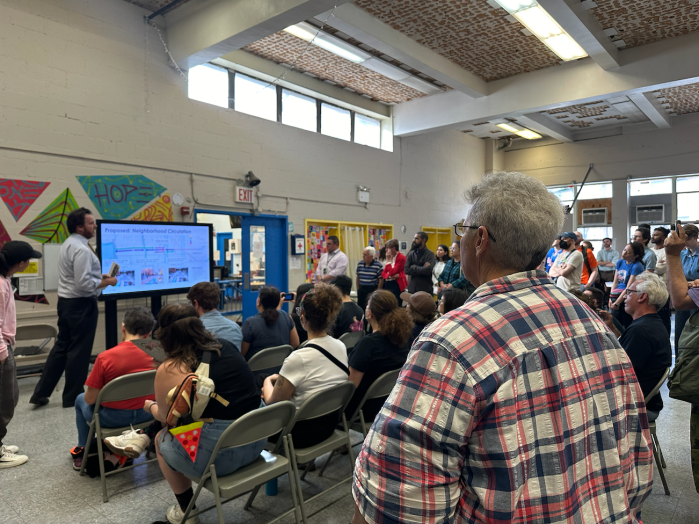
Astoria residents attended an open house, hosted by the Department of Transportation, to hear about the changes coming to their neighborhood. Photo by Iryna Shkurhan
June 3, 2024 By Iryna Shkurhan
At a community meeting in Astoria on Thursday, dozens of locals erupted in applause after the Department of Transportation (DOT) outlined its proposed changes to a major chunk of 31st Avenue.
The biggest potential change is an approximately mile-long stretch of parking-protected bike lanes. Converting the corridor to a one-way street for car traffic will make this change possible.
The agency added that they anticipate the project will kick off this summer and be completed by the end of the year, pending additional community input and the recommendation of the community board.
“There are some drastic changes coming here,” said Theodore Wright, Director of Bicycle and Greenway Programs at the DOT, during his presentation at the Variety Boys and Girls Club on 30th Road.
The proposal he outlined was developed with the input of over 2,400 community surveys that local residents completed in recent months. The two most prominently mentioned safety concerns were vehicles disregarding traffic signals and a lack of protected bike lanes.
In the survey comments, several specific streets that intersect with 31st Avenue were called out for the lack of perceived safety: 43rd Street, Vernon Boulevard, 31st Street, Crescent Street and 33rd Street.
Following the presentation, community members in attendance had the opportunity to examine the proposal closely, ask questions and offer specific suggestions. Many left post-it notes with their comments atop the maps outlining the proposed changes to 31st Avenue.
The proposed design has three separate design concepts for the one-mile stretch of 31st Avenue that encompasses Phase 1 of the safety redesign.
Between Vernon Boulevard and 31st Street, which is mostly residential and offers waterfront access, the DOT is proposing creating two-way bike lanes that will be protected by a parking lane. They leave just one lane of car traffic, with sections alternating directions.
Between 31st Street and 35th Street, the current parking lanes will be infused with pedestrian and programmable space to evoke a more open street feel. That four-block stretch already has a successful open street program on weekends and a range of businesses.
The proposal suggests creating a one-way shared lane heading west and a smaller contraflow bike lane directed east.
Further west, between 35th Street and Steinway, the DOT is proposing adding a two-way protected bike lane sheltered by a lane of parking. A one-way car travel lane headed west will remain in the area, which has more auto-focused businesses, schools and mostly residences.
The addition of pedestrian islands, particularly near intersections throughout the entire stretch, will eliminate some parking spots. However, this is not a significant loss because parking will still be available on both sides of the street.
Of the merchants on 31st Street who also participated in the survey, many mentioned a lack of curb access for deliveries. Others noted that businesses were choosing cyclists to deliver their goods over trucks.
But among the residents surveyed, the overwhelming majority said they want more pedestrian space combined with greenery, protected bike lanes, street seating, public art and more community programming.
“I want to make it very clear here. This is not about merchants, bike lanes, or anything else. This is about safety. Yes, bikes are part of the safety calculations. But overall, we really want to look at these places, and we want to see the design that’s going to make them safer for everyone,” added Wright during the presentation.
He also emphasized that the goal is to lessen the number of vehicles on the streets to make this specific corridor, 31st Avenue, safer for pedestrians and cyclists.
The DOT also felt comfortable proposing these changes after its findings showed that this corridor was on the more quiet side for car traffic, compared to nearby streets.
In terms of next steps, the DOT will present the proposal at the upcoming Community Board 1 meeting on June 18 where the board will vote on it.
Following the completion of this Phase 1 project, they will begin to propose Phase 2 changes to the blocks between Steinway Street and 51st Street, and traffic calming along Newtown Road.






